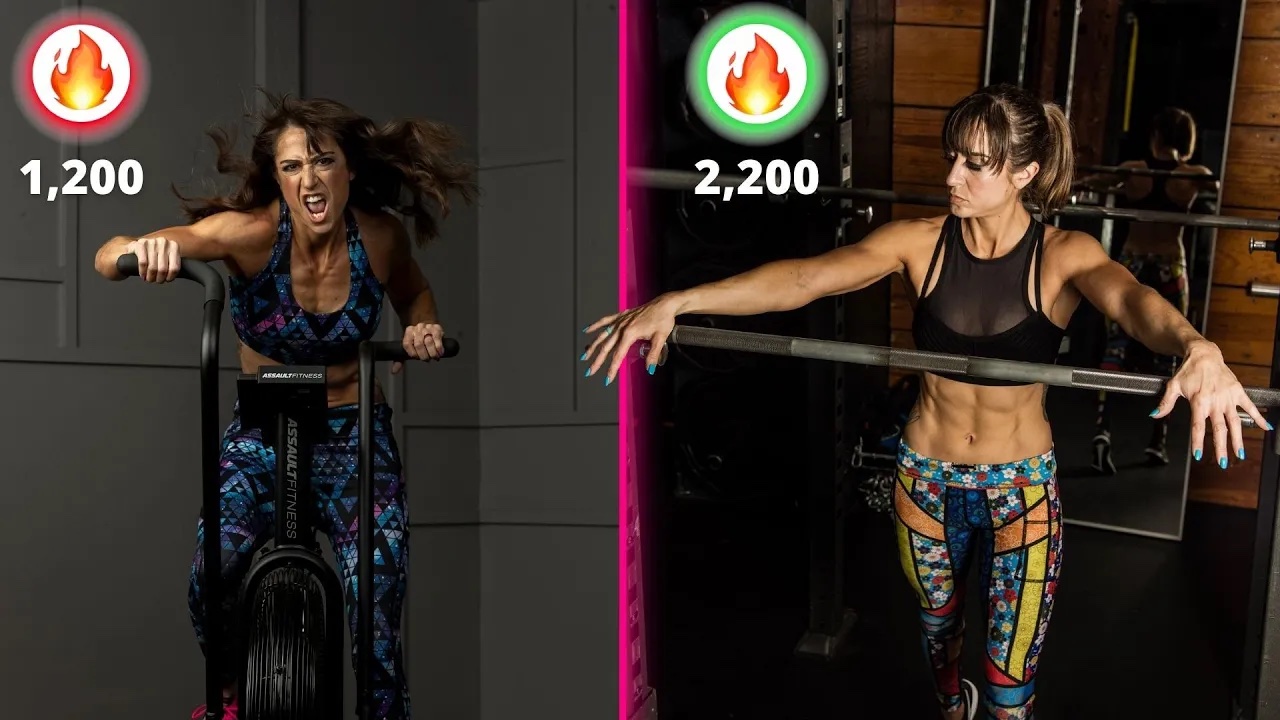The number one thing impacting your metabolic health isn’t your age…
It’s your muscle mass.
And so often as we get older, we DO lose muscle.
Not to mention previous dieting and workout practices for weight loss often cause us to lose muscle as we strive for faster results on the scale.
And this muscle loss is often why we see more metabolic decline and adaptations over time.
The great thing is…
We can REVERSE these things and improve our metabolic health at ANY age.
But boosting our metabolism isn’t just about our diet, it’s also about how we train.
We need to focus on training practices that create that stimulus for muscle growth while also helping us to burn more calories throughout the day.
More muscle requires more calories consumed to be maintained and more calories burned even at rest!
That’s why in this video I wanted to share 7 tips you can use to improve your training schedule and boost your metabolism

Tip #1: Work legs AND upper body in a workout.
Working two large muscle groups in a single session helps you burn more calories DURING the workout and build muscle faster.
This creates a greater calorie burn during the day for better fat loss results, but also raises your resting metabolic rate because of the added muscle.
More muscle means more calories burned even at rest to build and maintain it. Your energy demands go up!
By not only working two large muscle groups in general but specifically pairing LEGS and UPPER body in a session, you can promote an even more optimal hormonal environment for growth.
By doing legs BEFORE upper body in a session, studies have shown you release more testosterone and growth hormone, which can lead to faster muscle gains.
So whether you do butt and hamstrings with back exercises or quads and chest, consider pairing lower body with upper body in a workout.
This can help you get in more quality work for muscle groups not only in a single workout but over the week.
This is also a great way to pack in more to shorter training sessions, which can also lead to a better hormonal environment for growth.
Too often we make our sessions longer, leading to not only wasted volume but a rise in cortisol levels which can fight against our gains.
So alternate areas worked in your sessions so that one muscle group gets to rest as you work the other. This will keep your sessions shorter!
And make sure you’re focusing on big heavy compound lifts for each area for the bulk of your workout!
Tip #2: Use cluster sets to lift more.
We need to lift more weight to build muscle.
The more you can progress and lift, the faster you can build.
But this isn’t just about what you can lift for a single rep.
It’s about the total loads lifted overall for an area in individual workouts and even over weeks and months.
The more weight you move overall, the more you’ll see that growth.
But this weight lifted needs to also be quality work.
This is where cluster sets, especially for a compound exercise to start your workout can be an amazing tool to increase your training density and actually lift more weight overall for an area.
With cluster sets, you are breaking up your traditional set of 8 reps, into fewer reps, say just 2 or 3 in a row, with just 10-30 seconds of rest between those mini sets, before you rest longer and do another round.
Because you are only performing 2 or 3 reps before the short rest, you will find you can use more weight for the full 8 reps than you would have been able to if you had tried to just do 8 in a row.
You may also find you avoid that last kind of half done rep because of fatigue for quality reps all the way through.
More weight lifted in a set amount of time for quality reps leads to faster muscle growth and ultimately helps boost that metabolism!
Tip #3: Design shorter and harder workouts.
So often we focus on doing more, making our workouts longer and harder to try to make ourselves more sore, thinking that will lead to better results faster.
Instead we need to focus less on time and volume and more on quality, intensity and intentionality with everything we do.
Less is more when what we do is done well.
While we may feel like we are giving 100% as our workout gets longer and we do more reps and sets, that 100% intensity isn’t a true 100%.
If instead we focus on giving that full true 100% effort for less, we will see that quality pay off.
Not to mention hormone levels start to fight against us the longer those sessions get, especially if we aren’t including enough rest but instead just trying to do more reps and exercises for the same muscle.
While we don’t want to just demonize a hormone like cortisol because it does help promote fat metabolism, exercising for too long can elevate levels of cortisol to catabolize muscle protein for fuel instead of conserving it to be used to repair damaged tissues.
So we want to be conscious that we are including everything in our sessions with purpose and not just making them longer and longer to feel harder thinking that will lead to better gains!
Focus on quality and what you truly feel working with each rep. Be present in your workouts to push the effort and maximize everything you include!
Tip #4: Use interval finishers.
Keeping our heart healthy is key and strength training can be metabolic and improve our conditioning and cardiovascular healthy.
But it can also be key to include some cardio to help us recover faster so we can lift more.
Not to mention interval training can lead to more calories being burned even at rest while, if done strategically, not leading to muscle catabolism or impaired recovery.
Interval training can increase our EPOC or excess post exercise oxygen consumption…often called the afterburn.
And while no magic pill, this increase in energy expenditure to help us recover, repair and rebuild can lead to better fat loss results and offset some of the metabolic changes we’ve experienced as we build lean muscle.
Consider including short interval sessions as the end of your workouts, varying work to rest intervals.
Don’t add 20 minutes on to your workout, but consider interval work for about 5 minutes – whether you include longer work than rest like 20 on, 10 off or longer rest to work 10 on 30 off!
That variety can help you work different energy systems and even improve your recovery time to be able to lift more in your strength workouts!
Tip #5: REST REST AND…oh yea…REST
This is the least sexy of all 7 tips but the most important.
Your muscles only grow if they have time to repair and rebuild.
This doesn’t mean you have to wait a whole week before working an area again or that you won’t see gains if you do work a muscle on back to back days at times, but you want to be conscious that areas have time to recover.
And the more frequently you work an area in a week, the more you need to lower the number of reps and sets and work you do per session.
Focusing on rest also doesn’t just mean recovery between sessions but DURING your workout.
If you rush through sets without allowing yourself enough rest, you’re going to see your work output and intensity drop quickly.
This can lead to you feeling tired and challenged while not actually challenging yourself to the fullest extent possible.
It may be why you aren’t building muscle as fast as you’d like or really creating that anabolic hormonal environment for growth.
So don’t skip on the recovery!
It is truly the part so often overlooked that can fight against our muscle gains and perpetuate those metabolic adaptations.
Tip #6: Don’t forget your power work!
Explosive power work is not only key if you want to stay functional stronger and better able to avoid injury as you get older, but it can also help build muscle.
It helps us improve our mind-body connection and recruit muscles faster in the correct order, which also results in us being able to lift more.
Yet often we avoid it because we only think of it as jumping.
And while we shouldn’t avoid jumping as we get older, I also understand that injuries may not allow us to do that jump training as part of our explosive work, which can lead to us not doing any at all.
Not to mention, too often we lump in explosive power work to interval work when it needs to be its own set thing.
When doing power work, short explosive max effort intervals with longer rest periods are essential. Otherwise you end up fatiguing and training slowness.
You want to move quickly, go at 100% intensity then rest fully.And you want to do this when you are fresh.
Consider including power work before your first heavy lift after your warm up routine.
Including things like sprints, even on a bike if you want to reduce impact, or weighted exercises like med ball work, kettlebell swings or even Olympic lifts if you’re experienced, can lead to amazing muscle gains.
They can also promote optimal hormone levels, increasing growth hormone production, for our strength workouts!
Tip #7: Walk for recovery!
Our body was meant to move. Moving more is key to our health and even our fat loss results.
But we don’t want to just include workouts that beat us down.
That’s why walking is so key to include.
The extra movement can help us burn more calories while not being catabolic to our muscle mass.
It can help increase our metabolic rate while being a great restorative activity.
And if you can get outside to even get Vitamin D, it is a win win for your health and body recomp!
So if you’re someone that struggles to take time off, or you’re working to lose weight and want to fight those metabolic adaptations, include more walking in your routine, especially on “rest days.”
You can even add in some bonus mobility work before your walk to help your body recover for your next training sessions so you can push hard!
Metabolic changes happen but there is so much we can do to reverse them and see better fat loss results no matter our age.
However, we need to make sure we’re focusing on doing everything we can in our workouts to build that lean muscle if we want to increase our metabolic rate.
Use these 7 tips to boost your metabolism and see your hard work in the gym pay off!
Ready to accelerate your results with metabolism boosting workouts?



0 Comments